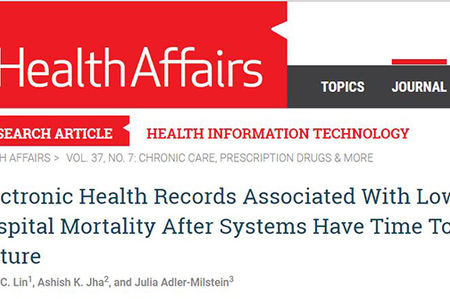Health Affairs: Electronic Health Records Associated With Lower Hospital Mortality After Systems

Health Affairs has published a paper, "Electronic Health Records Associated With Lower Hospital Mortality After Systems Have Time To Mature," co-authored by Sunny C. Lin, Ashish K. Jha and Julia Adler-Milstein, in research funded by The John A. Hartford Foundation.
Data were studied from 3,249 hospitals across the country, measuring quality by looking at 30-day mortality rates for 15 common conditions for patients who were 65 years and older. An examination of how the adoption of electronic health records (EHRs) affected the quality of hospital care between 2008 and 2013 found that mortality rates were initially higher among hospitals with more digital capabilities, but fell over time, as hospitals learned how to work with the technology and adopted new capabilities.
In addition, the study found significant differences for hospital size and teaching status, with mortality reduction from adoption greater for smaller hospitals and for nonteaching hospitals.
“In other industries, widespread digitization took a decade to realize improvements,” said UCSF’s Julia Adler-Milstein, PhD. “It’s a major transformation of the healthcare system to go from paper to digital. We are seeing those rewards, but it has taken time and work.”
To better parse the differential effects of EHR adoption, the researchers examined three distinct phases: baseline EHR functions; the maturation of these baseline functions; and the adoption of new EHR functions. “We measured EHR adoption in a way that was truer to the way adoption likely occurred. As hospitals added functionalities over time, there was benefit from each of those new features.”
“There’s been a lot of frustration with EHRs,” Adler-Milstein said. “Our study shows they are improving care. It just may not be as much as providers or policymakers wanted—or come as quickly, or as easily, as they would have liked.”
To read the paper, click here.
To learn about JAHF's funding, click here.
To read UCSF’s post on the release, click here.
